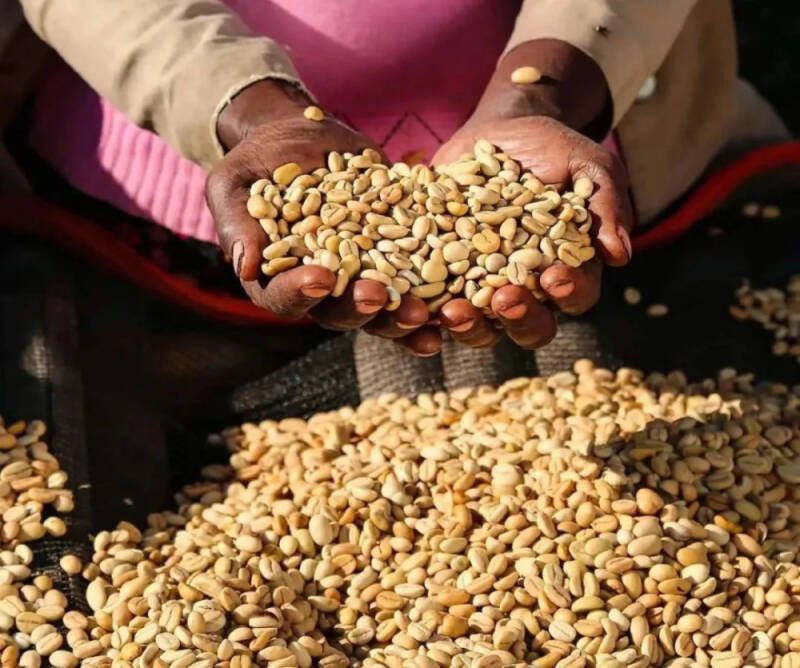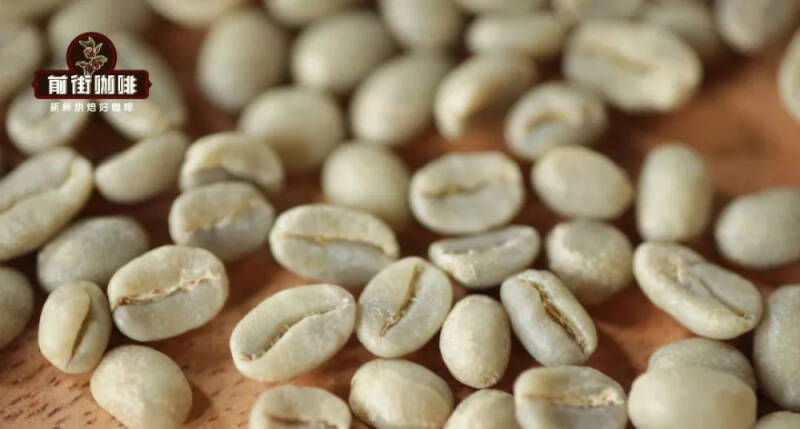Front Street Coffee Roasting Course ②: Understand and understand raw coffee beans! What impact will the size, density, and moisture content of beans have?
Qianjie mentioned in yesterday's article that learning to roast allows us to look at coffee from other angles and learn more about coffee! Yes, what I want to share on the front street today is to look at coffee beans from a baking point of view. If a cook wants to cook a dish well, then the right heat is essential! In addition to the skilled application of machines, the mastery of heat is inseparable from the understanding of ingredients! Some ingredients are suitable for slow stewing over low heat, and some are suitable for stir-frying over high heat. So let's move on to today's Qianjie baking class: getting to know the ingredients.

Different beans have different characteristics, for baking, in order to find a suitable set of baking "recipes", then it is necessary to understand the differences in bean size, moisture content and density.
Moisture content let's talk about moisture content first! Moisture content refers to the total weight of water in raw coffee beans, and the ideal moisture content for a coffee bean is in the range of 10.5% to 12.5%. The raw coffee beans with moisture content in this range can be stored for a long time and are not prone to qualitative change, and will have rich flavor after baking.

The moisture content will gradually decrease with the storage time of raw beans, when the moisture content is less than 10.5%, coffee beans will be easily roasted, and most of them will be boring after baking. When the moisture content of the treated coffee beans is higher than this range, it will make the raw coffee beans easy to breed mold in the storage process, and then produce the risk of mildew and deterioration, which will become difficult to store for a long time. For coffee roasting, the higher the moisture content, the more calories are needed for roasting.
Density and then the density of beans! The more nutrients a coffee bean absorbs, the higher its density will be! Generally speaking, the higher the altitude of the growth of the same variety, then it will have more time to absorb nutrients, making the bean body denser and harder. So most Central American countries will use altitude as the rating standard for coffee beans, the higher the altitude (the harder) the higher the grade. Similarly, the higher the density of beans, the more calories they need for baking, and it takes relative skill to bake them. (details are written in the size column)
The size is the size of the beans at last! Other things being more or less the same, the bigger the bean is, the more skillful it is to bake it. Because the large granule bean has a long distance between the bean surface and the bean core, it takes a certain amount of time for the heat to infiltrate the bean core to bake it. But if your firepower is too high, it is easy to see that the bean surface is fully cooked and the bean core is still raw, that is, the beans are unevenly heated and uncooked! Therefore, it is necessary to use the form of "slow stew" during baking to prolong the dehydration period of the previous stage, so as to ensure that the bean core and bean table can be heated evenly! This is the same for beans with high moisture content and high density.
Of course, there is also such a kind of beans, they will be planted and harvested, resulting in a bean with different size and density, which will bring great challenges to baking. For example, Ethiopia's native species, or matching beans.
Defective beans in raw coffee beans next we need to know those defective beans hidden in raw coffee beans. Even a batch of beans of high quality will more or less have some defective beans, which will affect the overall flavor of coffee! So before baking, we need to screen out these defective beans in order to ensure that the final coffee has a cleaner performance.
Shell beans / broken beans some coffee beans split apart due to developmental problems during growth, one of which is the core of the coffee bean and the other is the shell of the bean watch. Because the shape of the shell is more or less the same as that of the shell, it is called "shell bean".
On the other hand, broken beans are beans that are damaged by man-made damage during the processing or transportation of raw coffee beans. This kind of beans is particularly common under the wet planing treatment in Indonesia, after all, the wet planing sheller is more violent and is very easy to damage the coffee beans.
The existence of both is easy to make baking, extraction, uneven situation. So we can weed them out before baking.
Moth-eaten beans because coffee belongs to agricultural products, so in the process of coffee fruit growth, it is easy to be "favored" by pests called coffee bark beetles. Pests will gnaw from fruit to raw beans, which will leave small black holes in the surface of beans. Moth-eaten beans are not only prone to mildew, but also bring negative flavor to potions. So it is one of the objects we focus on getting rid of.
Moldy beans some coffee beans will become moldy because they are not completely dry (high moisture content) or improperly stored (moist environment), and these beans are called "moldy beans"! Moldy beans are easy to distinguish because they all have green mildew spots visible to the naked eye.
Moldy beans will bring a very strong mildew smell, but also damage the health of the human body. So you need to remove them before baking. At the same time, damaged beans and worm-eaten beans will also cause mildew beans, this is because the beans have a gap, water vapor and mold can invade, resulting in qualitative change.
Black beans, as the name implies, are relatively black beans. Their appearance is characterized by the fact that the local or whole body color is much darker than other conventional beans. There are many reasons for this kind of beans, such as coffee trees infected, coffee beans contaminated, or excessive fermentation will produce black beans. It is important to note that black beans have soil odor, which will be harmful to human health if not removed, so be sure to identify them carefully and pick them out.
Bai Mu Dou Bai Mu Dou, also known as Quick beans, can be said to be unripe coffee beans. This kind of beans is because the coffee fruits are picked before they are ripe, and the raw coffee beans extracted from these unripe fruits are white beans. Generally speaking, in the raw bean stage, it is difficult to distinguish them from other "ripe" raw beans, after baking, the difference between the two will be very obvious (color difference)! Immature raw beans do not accumulate enough nutrients to breed flavor substances, so after baking, the flavor of these beans is almost no, more is the baking taste of fried melon seeds! And it is easy to bring salty and astringent taste to the coffee.
In addition to the foreign bodies in coffee beans, in addition to defective beans, a batch of coffee beans may also be mixed with branches, small stones and other foreign bodies. They all have a negative impact on baking, so they are all objects that must be removed. To sum up, we'd better screen out all these defective substances before baking, so as to ensure that the final coffee beans will not be adversely affected by them. Although we will screen the defects again after baking, but then these beans that will damage the flavor will not be so easy to find!
-END-
Front Street Cafe
No. 10 Baoqian street, Yandun road, Dongshankou, Yuexiu district, Guangzhou, Guangdong province
Important Notice :
前街咖啡 FrontStreet Coffee has moved to new addredd:
FrontStreet Coffee Address: 315,Donghua East Road,GuangZhou
Tel:020 38364473
- Prev

Sweet, sour, bitter, salty and fresh, will there be umami flavor in coffee? Why can't you taste the umami in your coffee? How to feel the taste of coffee?
Regarding describing the taste of food, sweet, sour, bitter, salty and fresh, our tongues all have different taste receptors to sense and identify them. But as far as coffee is concerned, people generally only describe it in terms of acidity, sweetness, bitterness, salty taste, etc. These four flavors are also the types of flavors that we can most easily taste and detect in coffee. with
- Next

Limit QQ shows! Starbucks is coming to Bo Memory Kill?!
▲ Click to pay attention| Daily Boutique Coffee Culture Magazine Coffee Workshop Recently, a new Starbucks ice mug appeared on social platforms. Around the iconic mermaid logo are various qq emoticons. At first glance, you may think that a child used stickers to decorate Starbucks ice mug. Many people
Related
- What effect does Italian American coffee with filter paper have? Will coffee taste better if it is put on filter paper at the bottom of the powder bowl?
- What is the color difference in coffee beans? What are the characteristics of honey processed coffee beans? Why are the anaerobically treated coffee beans uneven in color?
- How does novice Xiaobai quickly get started and make coffee? Newbies learn to make coffee by hand and share the specific steps and process process!
- Costa tea has a shelf life of 100 years?! Expert: Unable to verify
- It's a huge uproar! American milk addition was rejected by Manner employees?!
- Mocha pot coffee bean recommendations| How fine and how much powder should be used for grinding? What parameter ratios do I need to use to make milk with Mocha pot coffee?
- What are the characteristics of the world's top ten coffee beans treated with Costa Rica honey? How to make black honey kadura from Tarazhu Pilon Processing Plant taste good?
- How to make deep-roasted coffee? What grinding water temperature does authentic Jamaica Blue Mountain No. 1 coffee use to brew it well?
- Selected high-grade rose summer coffee flavor tasting guide Why Panama rose summer has the aroma of flowers and fruits
- What equipment does a novice Xiaobai need to buy to learn to make coffee? Filter cup electronic scale bean grinder manual flushing pot purchase guide

